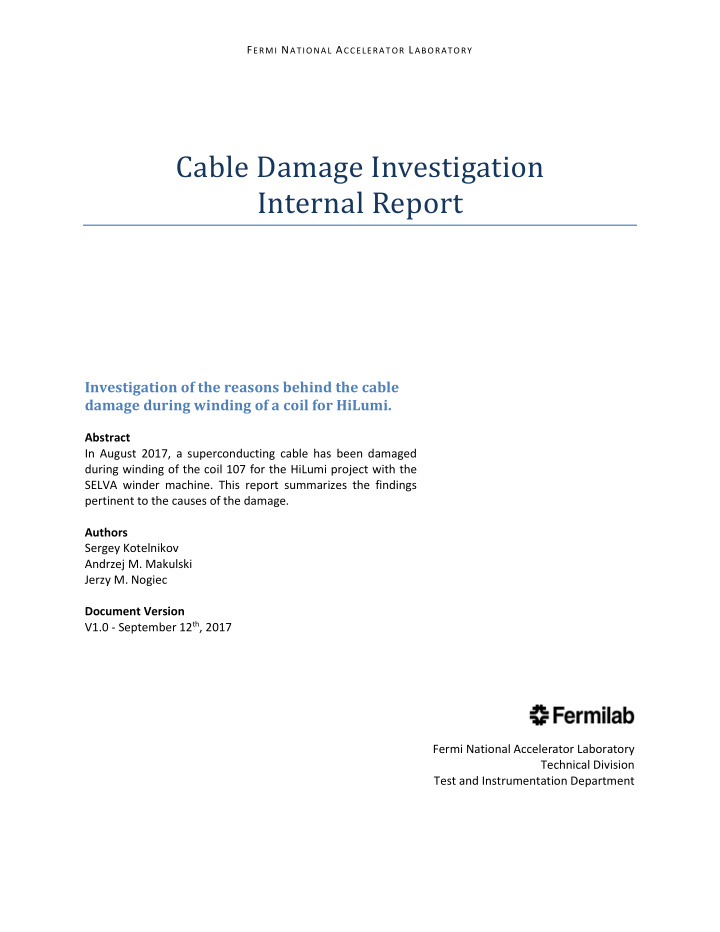



F ERMI N ATIONAL A CCELERATOR L ABORATORY Cable Damage Investigation Internal Report Investigation of the reasons behind the cable damage during winding of a coil for HiLumi. Abstract In August 2017, a superconducting cable has been damaged during winding of the coil 107 for the HiLumi project with the SELVA winder machine. This report summarizes the findings pertinent to the causes of the damage. Authors Sergey Kotelnikov Andrzej M. Makulski Jerzy M. Nogiec Document Version V1.0 - September 12 th , 2017 Fermi National Accelerator Laboratory Technical Division Test and Instrumentation Department
Cable Damage Investigation Report Introduction On August 9, 2017, a report was made regarding damage to a short section of the superconducting cable during winding operations of the HiLumi project at the SELVA machine. The authors were summoned to investigate the core reasons of the damage in an attempt to eliminate similar incidents in the future. When the T&I personnel arrived at IB3 (where winding operations take place), the machine state had already been altered from the state when the incident happened. The authors were told that the direct reason for the cable damage was the elevated position of the reel with the superconducting cable, which caused the bending of the cable at some tension. This resulted in local deformation of the cable. Approach Inferences as to the sequence of events leading to the damage have been done based on the machine- generated logs, since the position of the reel with the cable has been changed from the actual position at the time of the event, and there are no pictures of the machine elements at the moment of the damage. The logs contain time-stamped entries for all commands executed by the machine as well as any warnings or exceptional situations reported by the machine control system. All operator commands, regardless of their origin (the host HMI with keyboard and touchscreen, the remote controller or the auxiliary remote control unit), are recorded in daily operations logs. The authors also inspected the mechanical, electrical and functional aspects of controlling the reel position/height. Findings The investigation produced the following conclusions: • The log shows that the automatic mode was not activated prior to the incident that day, therefore, the reel control was being operated in the manual mode- with the operators having full control and responsibility for the position of the reel. Note that there are no manual reel control commands registered prior to the cable damage event. After the event, the reel was manually lowered using a sequence of user commands issued from the system HMI, and then reel regulation was switched to automatic. • The machine behaved as expected. There is completely no evidence of any hardware or software fault. • Inspection of reel movements, its upper and lower travel limits, movement speed, cable position sensors and reel position stability showed absolutely no problems, with all values as designed and expected. Page 2 of 3
Cable Damage Investigation Report Summary and Recommendations The authors conclude that the cable damage was a result of a human error. In particular, by choosing to not use the automatic control, the operators chose to take full responsibility for controlling the position of the reel. Thus, when proceeding with the winding using the manual mode of controlling the reel, there must have been inadequate attention paid to the reel position with the damaged cable as its result. This is a deviation from the SELVA operating procedures. The SELVA Operating Procedure manual lists starting the automatic reel control as one of the steps in placing the machine into the operating mode. In standard coil winding operations, the reel’s automatic control should be always active so that the machine control system is responsible for elevating and lowering the cable spool in order the keep the cable straight and to prevent damaging it. Furthermore, the reel up/down velocity has been set to a low enough value in manual mode to provide the human operator with ample time to supervise and control the reel’s elevation. The SELVA Operating Procedure manual specifically recommends that winding operations should be conducted by a two-person team, with both operators trained and certified to operate the SELVA winder. This is important for both human safety and protection of the coils being wound and the superconducting cable. It would be beneficial to preserve the state of the machine at the moment of occurrence of any significant exceptional situation, like the one encountered on August 9. This would facilitate a post mortem investigation targeted at discovering the root causes of such an event. Page 3 of 3
Recommend
More recommend